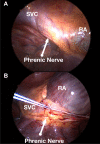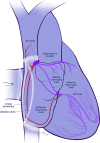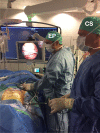Sinus node sparing novel hybrid approach for treatment of inappropriate sinus tachycardia/postural sinus tachycardia: multicenter experience
- PMID: 34424446
- PMCID: PMC9151552
- DOI: 10.1007/s10840-021-01044-5
Sinus node sparing novel hybrid approach for treatment of inappropriate sinus tachycardia/postural sinus tachycardia: multicenter experience
Abstract
Background: The ideal treatment of inappropriate sinus tachycardia (IST) and postural orthostatic tachycardia syndrome (POTS) still needs to be defined. Medical treatments yield suboptimal results. Endocardial catheter ablation of the sinus node (SN) may risk phrenic nerve damage and open-heart surgery may be accompanied by unjustified invasive risks.
Methods: We describe our first multicenter experience of 255 consecutive patients (235 females, 25.94 ± 3.84 years) having undergone a novel SN sparing hybrid thoracoscopic ablation for drug-resistant IST (n = 204, 80%) or POTS (n = 51, 20%). As previously described, the SN was identified with 3D mapping. Surgery was performed through three 5-mm ports from the right side. A minimally invasive approach with a bipolar radiofrequency clamp was used to ablate targeted areas while sparing the SN region. The targeted areas included isolation of the superior and the inferior caval veins, and a crista terminalis line was made. All lines were interconnected.
Results: Normal sinus rhythm (SR) was restored in all patients at the end of the procedure. All patients discontinued medication during the follow-up. After a blanking period of 6 months, all patients presented stable SR. At a mean of 4.07 ± 1.8 years, normal SN reduction and chronotropic response to exercise were present. In the 51 patients initially diagnosed with POTS, no syncope occurred. During follow-up, pericarditis was the most common complication (121 patients: 47%), with complete resolution in all cases. Pneumothorax was observed in 5 patients (1.9%), only 3 (1.1%) required surgical drainage. Five patients (1.9%) required a dual-chamber pacemaker due to sinus arrest > 5 s.
Conclusions: Preliminary results of this multicenter experience with a novel SN sparing hybrid ablation of IST/POTS, using surgical thoracoscopic video-assisted epicardial ablation combined with simultaneous endocardial 3D mapping may prove to be an efficient and safe therapeutic option in patients with symptomatic drug-resistant IST and POTS. Importantly, in our study, all patients had a complete resolution of the symptoms and restored normal SN activity.
Keywords: Arrhythmias ablation; Hybrid ablation; Hybrid therapy; Inappropriate sinus tachycardia; Postural orthostatic tachycardia; Sinus node.
© 2021. The Author(s).
Figures







References
-
- Sheldon RS, Grubb BP, 2nd, Olshansky B, Shen WK, Calkins H, Brignole M, Raj SR, Krahn AD, Morillo CA, Stewart JM, et al. 2015 Heart Rhythm Society expert consensus statement on the diagnosis and treatment of postural tachycardia syndrome, inappropriate sinus tachycardia, and vasovagal syncope. Heart Rhythm. 2015;12:e41–63. doi: 10.1016/j.hrthm.2015.03.029. - DOI - PMC - PubMed
Publication types
MeSH terms
LinkOut - more resources
Full Text Sources
Medical
Research Materials

